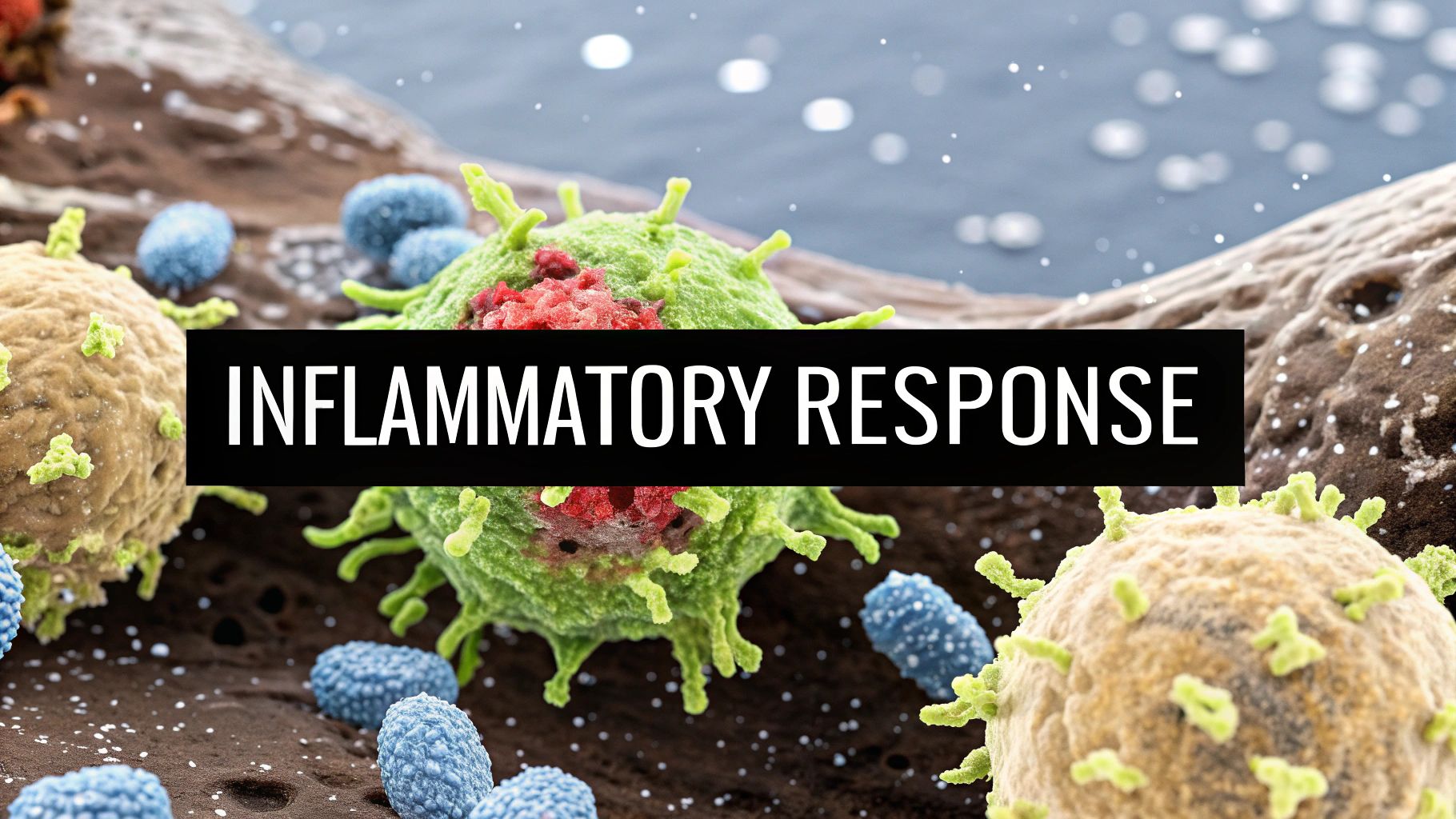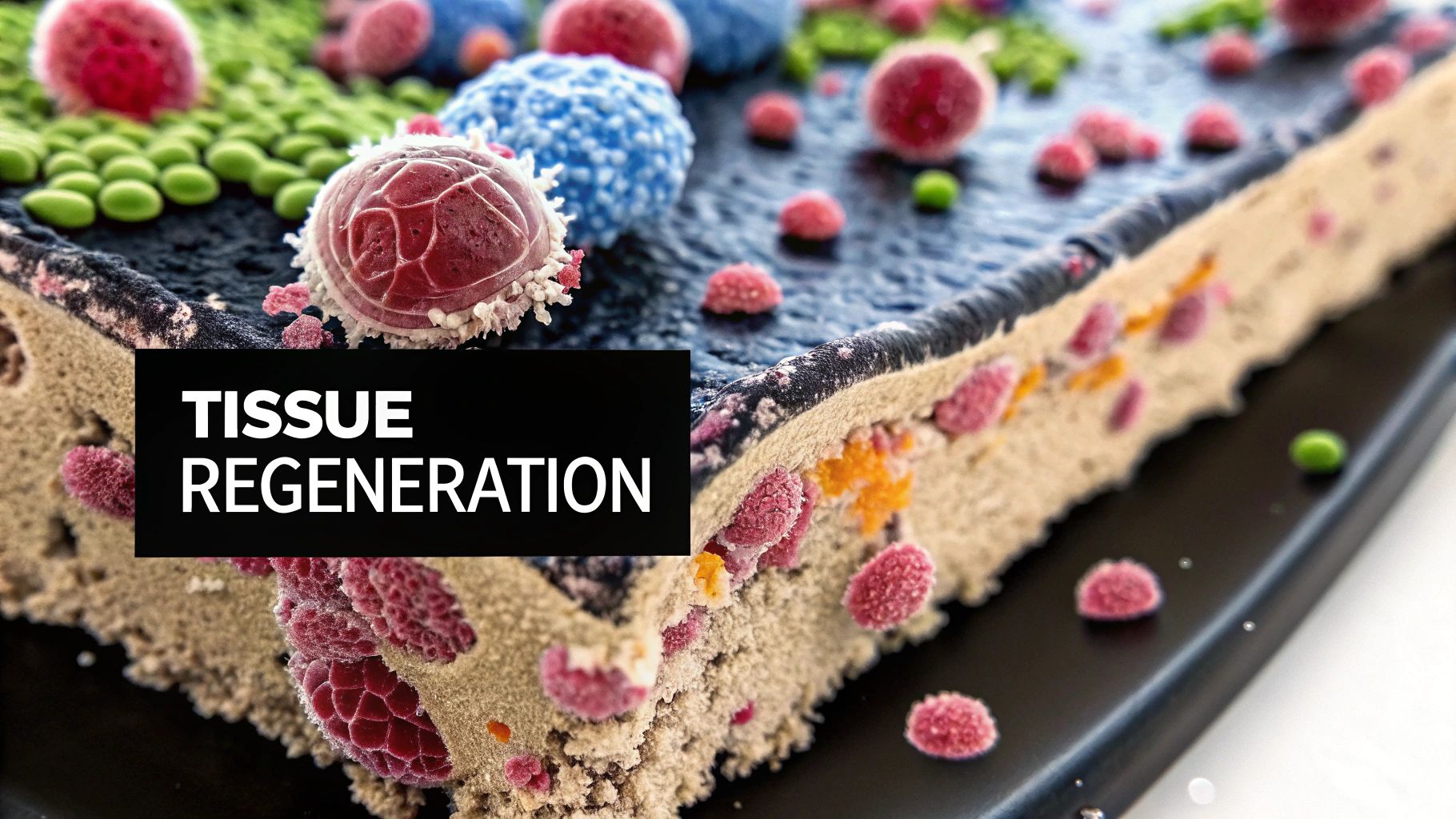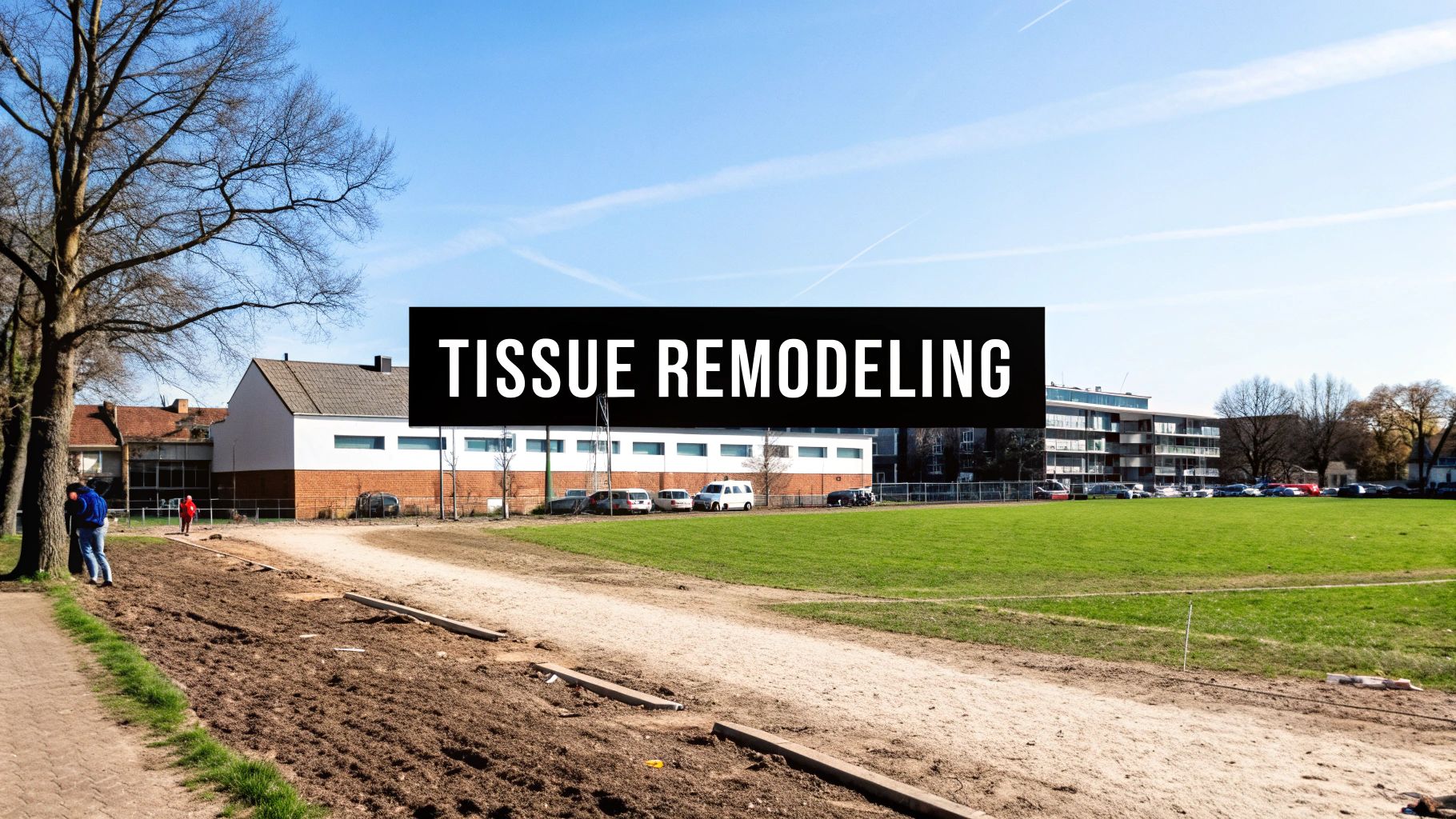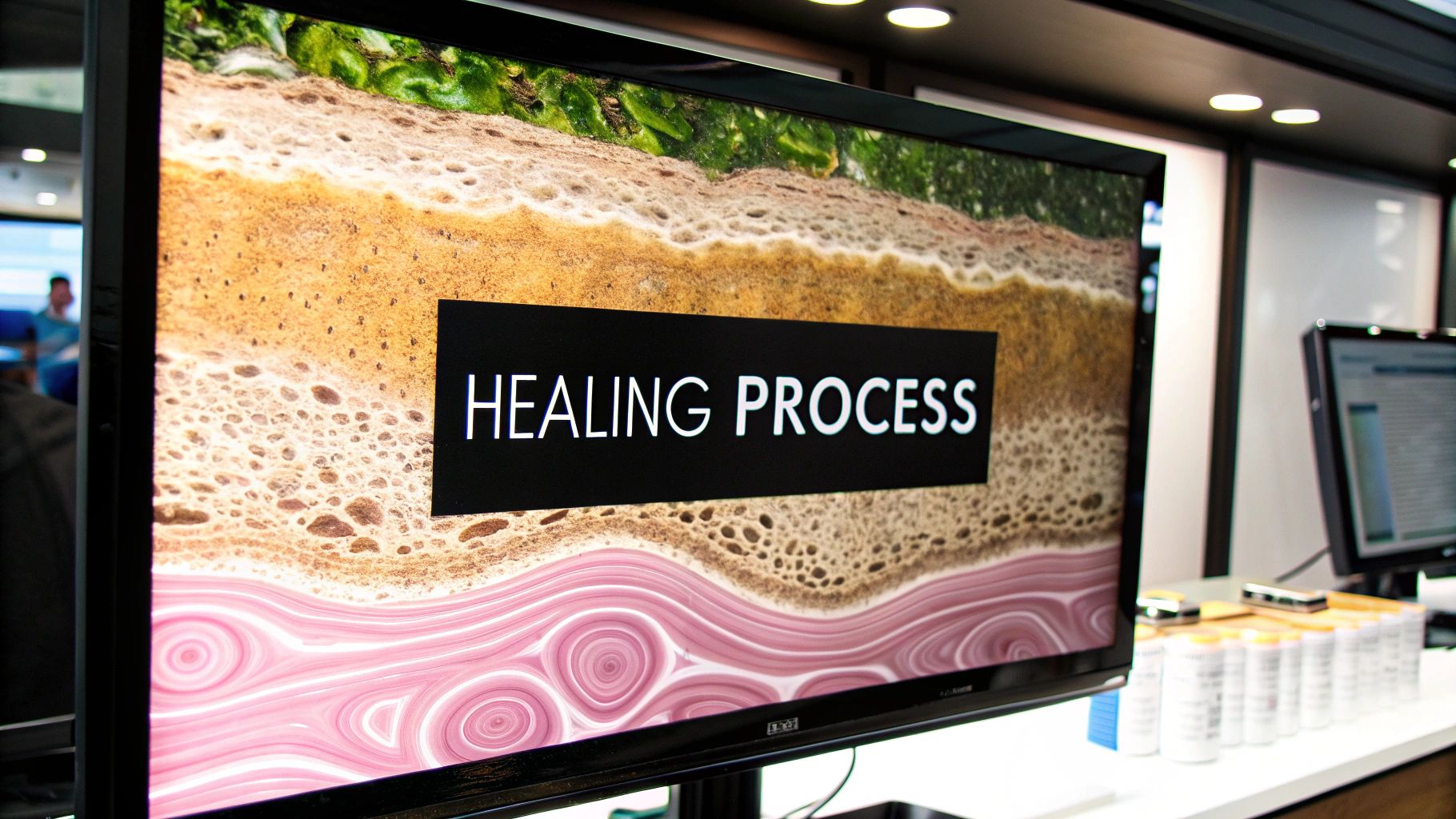Our bodies have an amazing ability to heal after an injury. This intricate process, called wound healing, involves a complex interaction of cells and systems working together. Understanding this process is key to effective treatment and a smooth recovery. It empowers patients and healthcare professionals to make smart decisions for better healing.
Acute Vs. Chronic Wounds: Two Different Healing Paths
A key difference in wound healing lies in the distinction between acute and chronic wounds. An acute wound, like a small cut or a surgical incision, typically heals in predictable stages, resulting in complete closure.
Chronic wounds, such as diabetic ulcers or pressure sores, don’t follow this normal healing path. They often get stuck in the inflammatory phase, unable to progress through the necessary steps for full repair. This highlights the importance of identifying the specific wound type for proper treatment.
The Orchestrated Repair Process: A Symphony of Cells
How your body heals a wound demonstrates its incredible capacity for complex processes. It’s like a well-coordinated orchestra, with each cell type playing a distinct part. Immune cells rush to the scene first, cleaning the wound and fighting infection.
Then, specialized cells called fibroblasts create new tissue, bridging the injured area. Finally, the body remodels the healed tissue, strengthening it and restoring function. This precisely timed sequence underscores the need to support each stage of healing.
Understanding the prevalence of chronic wounds adds another layer of complexity. These wounds affect roughly 1.67 per 1,000 people worldwide, with chronic leg ulcers being the most common type, impacting about 1.51 per 1,000 people.
In the United States, this translates to about 2% of the population dealing with chronic wounds, significantly impacting the healthcare system. The growing wound care market, expected to hit $18.7 billion by 2027, reflects the economic burden of these persistent wounds. Effective management is crucial to prevent serious complications. Find more detailed statistics here.
This intricate interplay of biological processes highlights the wonder of wound healing. Knowing the various wound types, understanding the stages of healing, and appreciating the factors that influence the process allows us to better support our bodies. This knowledge is essential not only for individual wound care but also for addressing the broader challenges of chronic wounds in healthcare.
The Four Critical Stages of How Wounds Heal

Our bodies possess an incredible ability to heal. Understanding the four key stages of wound healing, from the initial injury to complete recovery, allows you to best support this natural process. Let’s delve into the remarkable work happening beneath your skin.
Hemostasis: The First Responder
Hemostasis, the initial stage, starts immediately after injury. It’s your body’s emergency response to stop bleeding. Platelets, crucial components of blood, rush to the injury site and cluster together, forming a clot. This clot acts like a plug, sealing the wound and preventing further blood loss, typically within minutes of the injury.
Inflammation: The Clean-Up Crew
Next comes the inflammatory phase, often marked by redness, swelling, warmth, and sometimes pain. These are signs of your immune system at work. White blood cells arrive to cleanse the wound, removing debris, bacteria, and damaged tissue. This crucial step prepares the wound for tissue repair and can last from a few days to a week.
Proliferation: Rebuilding and Repairing
Once the wound is clean, the proliferation phase begins the rebuilding process. Fibroblasts, specialized cells, enter the wound and produce collagen, the building block of new tissue. New blood vessels also develop, providing oxygen and nutrients crucial for tissue growth. This rebuilding phase can span several weeks.
Remodeling: The Finishing Touches
The final stage, remodeling, is essential for long-term wound strength. During this phase, the initial collagen fibers are reorganized and strengthened, creating a more robust and flexible scar. This process, while showing noticeable improvement within a few months, can continue for up to two years.
To further illustrate these stages, let’s examine the following table:
The Four Phases of Wound Healing: This table breaks down each phase of wound healing by timeline, key cells involved, primary activities, and visible signs.
| Phase | Timeline | Key Cells Involved | Primary Activities | Visible Signs |
|---|---|---|---|---|
| Hemostasis | Minutes | Platelets | Blood clotting, stopping bleeding | Blood clot formation |
| Inflammation | Few days to a week | White blood cells | Cleaning the wound, removing debris and bacteria | Redness, swelling, warmth, pain |
| Proliferation | Several weeks | Fibroblasts | Producing collagen, building new tissue, growing new blood vessels | New tissue formation, wound contraction |
| Remodeling | Up to two years | Fibroblasts | Strengthening and reorganizing collagen fibers, scar maturation | Scar tissue becoming less visible and more flexible |
As you can see, each phase plays a vital role in the complete healing process.
Understanding these four stages—hemostasis, inflammation, proliferation, and remodeling—is crucial for facilitating recovery. By appreciating each phase, you can support your body’s natural healing. For wounds not healing correctly, consulting a healthcare professional at Rapid Wound Care is recommended. They can assess your specific situation and provide appropriate interventions.
What’s Helping or Hindering Your Healing Process?

Wound healing is a complex journey, not a one-size-fits-all experience. Numerous factors influence how quickly and completely your body can repair itself. Understanding these factors allows you to actively participate in your own recovery. Let’s delve into the key elements that can either aid or obstruct this intricate process.
The Role of Nutrition: Fueling the Repair Process
Proper nutrition provides the necessary building blocks for tissue regeneration. Protein, for instance, is essential for creating new cells and collagen, the primary structural protein in our skin and connective tissues. Vitamins C and A also play critical roles in collagen production and immune system function. A balanced diet rich in these nutrients can significantly improve your body’s ability to heal.
Underlying Health Conditions: Addressing Systemic Factors
Certain health conditions can present challenges to effective wound healing. Diabetes, for example, can impair blood flow and compromise the body’s ability to fight infection, two crucial components of healing. Other conditions, such as autoimmune diseases, can also disrupt the normal inflammatory response, which may delay the healing process.
Medications: Understanding Potential Side Effects
Even medications prescribed for unrelated health issues can impact wound healing. Some medications, such as steroids, can suppress the immune system, making it harder to combat infection and repair tissue. Certain blood thinners can also increase bleeding risk, potentially complicating the initial stages of healing.
The Impact of Age: Recognizing Natural Changes
As we age, our bodies naturally change, and these changes can affect how wounds heal. Older adults often have thinner skin and reduced blood circulation, potentially slowing down the healing process. However, maintaining good overall health and managing any underlying conditions can promote optimal healing at any age.
Environmental Factors: Creating the Right Conditions
External factors also play a critical role. Maintaining proper wound moisture is vital, as dry wounds heal more slowly. Temperature also influences healing; wounds typically heal more quickly in warmer environments. Protecting the wound from further injury is also paramount for uninterrupted healing. These factors underscore the importance of correct wound care techniques.
The global wound management market, valued at $30.0 billion in 2023, is projected to grow at a 3.8% CAGR. This growth is influenced by factors like an aging population and the increasing prevalence of chronic diseases. Learn more here. Understanding these interwoven factors allows us to create the best possible healing environment. This empowers us to take an active role in our recovery and optimize our healing journey.
When Healing Stalls: Understanding Chronic Wound Challenges
Sometimes, despite our best efforts, wounds simply refuse to heal. This can be incredibly disheartening for both patients and healthcare professionals alike. This section explores the reasons why some wounds transition into chronic wounds, remaining inflamed and unable to progress through the typical stages of healing.
Identifying Chronic Wounds: A Closer Look
Chronic wounds differ significantly from acute wounds. A simple cut might heal within days or weeks. However, chronic wounds can linger for months, or even years. This delayed healing is often due to underlying issues that disrupt the body’s natural healing process.
Pressure injuries, for instance, can develop in mere hours and quickly become chronic if the source of pressure isn’t removed. Diabetic foot ulcers, a serious complication of diabetes, can persist due to impaired circulation and nerve damage. Recognizing these distinct wound types is crucial for effective management.
Warning Signs: Differentiating Between Normal and Problematic Healing
Variations in healing don’t always indicate a problem. However, some signs warrant closer attention. Increased pain, persistent swelling, a foul odor, or a change in wound color could signal a developing complication.
Excessive drainage or the formation of new, easily bleeding tissue should also prompt a consultation with a healthcare professional. These warning signs can help differentiate between the normal variations in healing and situations requiring medical intervention.
The Challenge of Biofilms: An Invisible Barrier
A significant obstacle in chronic wound healing is the presence of biofilms. These are complex colonies of bacteria that cling to the wound surface. They form a protective shield against the body’s immune system and even resist antibiotics.
Biofilms significantly hinder the healing process. Disrupting these biofilms is a key focus in chronic wound care. Modern approaches utilize specialized dressings and debridement techniques to break down these biofilms and encourage healing. Inflammation also plays a significant role, and addressing it effectively is important.
The Economic Impact of Chronic Wounds
The increasing prevalence of chronic wounds carries significant economic consequences. The global wound care market was valued at $3.46 billion in 2025 and is projected to grow annually by 0.35% through 2029.
This growth is fueled by the demand for advanced wound care products, such as bioactive dressings and negative pressure wound therapy, which offer improved healing outcomes. Factors like local healthcare infrastructure and economic stability also influence the market. Regions with well-established healthcare systems tend to adopt advanced solutions more quickly. The rise of telemedicine, particularly during the COVID-19 pandemic, now plays a crucial role in providing more accessible and consistent care for patients with chronic wounds. Learn more here. Understanding the economic impact underscores the need for effective prevention and treatment strategies.
Recognizing the challenges posed by chronic wounds is crucial for anyone experiencing or caring for slow-healing injuries. This knowledge helps determine when self-care is sufficient and when professional intervention becomes necessary. Prompt and appropriate care can prevent complications and improve overall healing results.
Cutting-Edge Approaches to Accelerate How Wounds Heal

Wound care has evolved significantly. Instead of just covering a wound, treatments now actively encourage the body’s natural healing process. This section explores several advanced wound care approaches, explaining how they work and who can benefit.
Smart Dressings: More Than a Simple Cover
Traditional dressings mainly protect wounds. Smart dressings, on the other hand, actively contribute to healing. Some contain ingredients that stimulate tissue growth, while others absorb excess fluid or deliver medication. These advanced dressings foster a better healing environment, often reducing healing time and improving overall results.
Negative Pressure Wound Therapy: An Optimal Healing Environment
Negative pressure wound therapy (NPWT), sometimes called vacuum-assisted closure, uses gentle suction to remove extra fluid and improve blood flow to the wound. This creates an optimal healing environment, particularly beneficial for complex or chronic wounds. NPWT can significantly decrease healing time and enhance the quality of new tissue.
Bioengineered Skin Substitutes: A Tissue Replacement Solution
For severe wounds with extensive tissue loss, bioengineered skin substitutes offer a remarkable solution. Grown in a lab, these products can replace damaged or lost skin. They provide a framework for new tissue to grow, helping wounds close faster while reducing the risk of infection and scarring.
Emerging Therapies: Expanding the Horizons of Wound Care
Beyond these established approaches, research continues to explore promising new therapies. Platelet-rich plasma (PRP) therapy uses a concentrated solution of the patient’s own platelets to boost healing. Hyperbaric oxygen therapy increases oxygen delivery to the wound, encouraging tissue repair. These treatments hold potential, and studies continue to evaluate their effectiveness for various wound types. Honest evaluations are critical for understanding their true benefits.
To help illustrate the various treatment options, we’ve compiled the following table:
This table compares different wound care technologies, outlining their mechanisms, ideal use cases, associated costs, and the strength of supporting evidence.
Modern Wound Care Approaches: Comparing Effectiveness
| Treatment Approach | Mechanism of Action | Best For | Relative Cost | Evidence Strength |
|---|---|---|---|---|
| Smart Dressings | Release growth factors, absorb exudate, deliver medication | Minor to moderate wounds, burns | Moderate | Strong |
| Negative Pressure Wound Therapy (NPWT) | Removes excess fluid, promotes blood flow | Chronic wounds, complex wounds, surgical wounds | High | Strong |
| Bioengineered Skin Substitutes | Replaces damaged tissue, provides scaffold for new growth | Severe burns, large wounds, non-healing ulcers | Very High | Moderate to Strong |
| Platelet-Rich Plasma (PRP) | Concentrated platelets stimulate tissue regeneration | Soft tissue injuries, tendon injuries, some chronic wounds | High | Moderate |
| Hyperbaric Oxygen Therapy | Increases oxygen delivery to tissues | Diabetic foot ulcers, radiation injuries, compromised grafts | High | Moderate |
This comparison highlights the range of options available, from simpler dressings to advanced therapies, each designed to address specific wound care challenges. Cost and the level of scientific evidence supporting each approach are also important considerations.
Choosing the Right Approach: Personalized Care for Optimal Healing
The most effective wound care is tailored to the individual’s needs and the specific wound. A simple surgical cut might heal well with a standard dressing and good hygiene. However, a chronic diabetic ulcer might benefit from advanced therapies like NPWT or bioengineered skin substitutes. Understanding wound healing and the various treatment options allows patients to make informed choices with their healthcare team. This collaborative, personalized approach results in the best possible outcomes. If you are dealing with a persistent wound, connect with a wound care specialist at Rapid Wound Care to explore treatment options.
Supporting Your Body’s Natural Healing Powers
Your daily choices play a significant role in how effectively your wounds heal. Through practical advice and evidence-based information, we’ll break down the science of healing into easy-to-follow steps you can implement immediately. Let’s explore how lifestyle choices create the best possible internal environment for your body’s natural healing processes.
The Power of Protein: Building Blocks for Repair
Protein is essential for wound healing. It supplies the necessary amino acids to create new cells and repair damaged tissue. Think of protein as the fundamental building blocks for restoring your skin. During the recovery period, your body requires more protein than usual. Sufficient protein intake ensures your body has the resources it needs for effective wound repair.
Essential Nutrients: Supporting Tissue Regeneration
Besides protein, other nutrients are vital. Vitamin C is crucial for collagen synthesis, the development of new blood vessels, and proper immune function. Vitamin A also contributes to cell growth and immune responses. Zinc aids in cell division and protein synthesis. Getting enough of these nutrients through a balanced diet or supplements, as recommended by a healthcare professional, optimizes wound healing.
Wound Cleaning: A Gentle Approach
Proper wound cleaning is essential for preventing infection and promoting healing. However, harsh cleansers can damage the fragile new tissue developing in the wound. Gentle cleansing with mild soap and water is generally sufficient for most wounds. Avoid using antiseptic solutions unless specifically instructed by a healthcare professional, as they can hinder the healing process.
Debunking Wound Care Myths: Separating Fact From Fiction
Many common wound care practices can actually impede healing. For example, keeping a wound constantly dry can slow down repair. A moist wound environment often promotes faster, more efficient healing. Picking at scabs disrupts new tissue formation and increases the risk of scarring. Understanding and avoiding these common mistakes can significantly impact your recovery. Researchers are exploring advanced approaches like cell-based therapy to accelerate wound healing.
Recognizing Red Flags: When to Seek Medical Attention
While most wounds heal without complications, some require professional medical attention. Signs of infection, like increasing pain, redness, swelling, pus, or a foul odor, warrant immediate medical evaluation. Wounds that show no improvement after several weeks or are excessively deep or large should also be examined by a healthcare professional.
Lifestyle Factors: Optimizing Your Internal Healing Environment
Beyond specific wound care practices, your overall lifestyle significantly affects healing. Adequate sleep is vital for cell regeneration and immune function. Managing stress is also important, as chronic stress can suppress the immune system and slow down healing. Staying hydrated supports optimal cell function and nutrient delivery to the wound. Even moderate exercise, as long as it doesn’t directly stress the wound, can improve circulation and promote healing.
By focusing on these key elements—sufficient protein and nutrient intake, gentle wound cleaning, avoiding harmful practices, recognizing warning signs, and maintaining a healthy lifestyle—you empower your body to heal efficiently. Wound healing is a dynamic process influenced by many factors. Taking proactive steps to support your body’s natural healing capabilities can significantly improve your recovery.
For expert wound care and personalized treatment plans, contact Rapid Wound Care today. Their team of certified professionals provides comprehensive at-home wound care services to help you achieve optimal healing and enhance your overall well-being.

